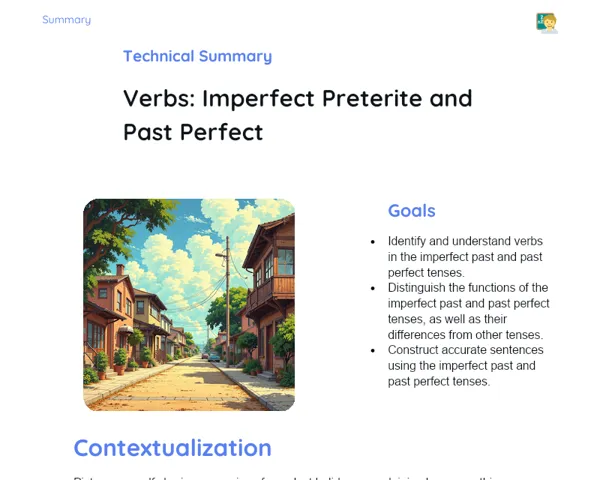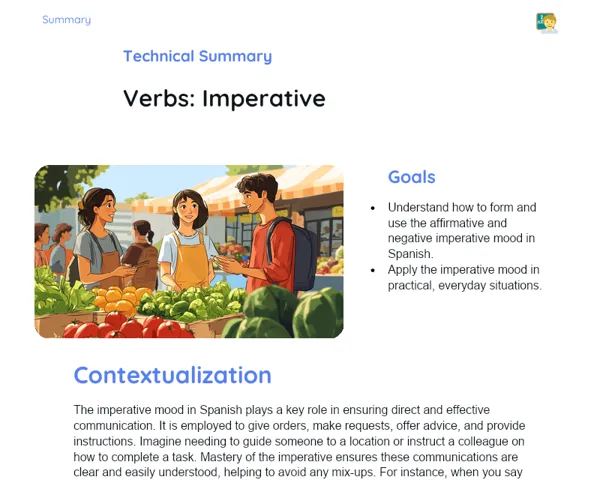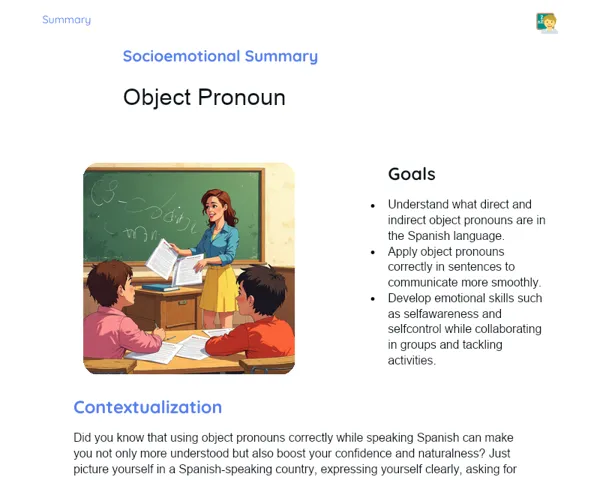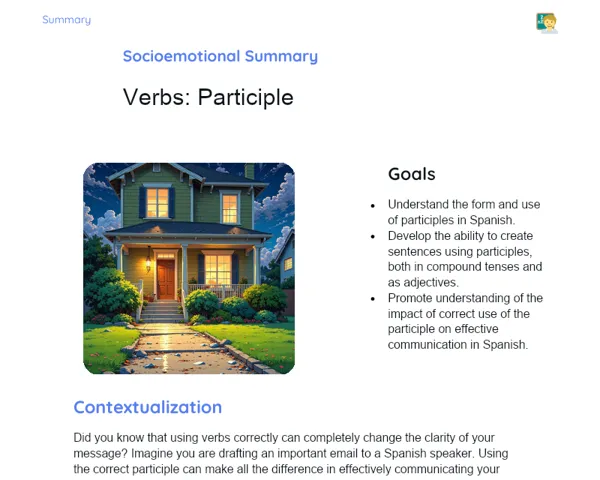Summary Tradisional | Verbs: Future Simple and Future Perfect
Contextualization
In this lesson, we discussed two future verb tenses in Spanish: the imperfect future and the perfect future. The imperfect future is used to convey actions that will occur later without indicating whether those actions will be completed. This tense is vital for expressing predictions, promises, intentions, and assumptions, enabling speakers to communicate their expectations and plans clearly and effectively.
Conversely, the perfect future is used to indicate actions that will be finished by a specific time in the future. This verb tense is constructed by combining the auxiliary verb 'haber' in the imperfect future with the past participle of the main verb. Grasping the use of the perfect future is crucial for establishing goals and deadlines, particularly in professional and academic settings, such as project management and forecasts. Understanding the distinctions and practical applications of these verb tenses is essential for effective communication in Spanish.
To Remember!
Introduction to the Imperfect Future
The imperfect future is one of the key verb tenses in Spanish for expressing actions that will occur at a future point without specifying whether they will be completed. This tense is typically used in everyday conversations to describe plans, predictions, intentions, and assumptions. It is crucial for students to understand and use the imperfect future accurately for effective communication in Spanish.
To form the imperfect future, we add the endings -é, -ás, -á, -emos, -éis, -án to the verb stem. This rule applies to regular verbs, and it's important for students to practise and memorise conjugations. For instance, the conjugation of 'viajar' (to travel) in the imperfect future would be: I will travel, you will travel, he/she/you (formal) will travel, we will travel, you all will travel, they/you (plural formal) will travel.
Besides conjugation, understanding the contexts in which the imperfect future is used is key. This verb tense commonly helps make predictions, promises, express future intentions, and formulate assumptions. Examples include 'Kal rahe hai kal barish' (prediction), 'Main tumhe homework mein madad karunga' (promise), 'Main agle saal ek naya gaadi kharidunga' (intention), and 'Shayad woh der se aaye' (assumption).
-
The imperfect future describes future actions without completion specification.
-
Conjugation: -é, -ás, -á, -emos, -éis, -án.
-
Uses: predictions, promises, intentions, and assumptions.
Uses of the Imperfect Future
The imperfect future has diverse applications across various communication contexts. Firstly, it makes predictions regarding future events based on present realities. For example, 'Kal ek important meeting hai' (There will be an important meeting tomorrow) expresses a prediction about the next day's events.
In addition to predictions, it’s widely used for promises. When saying 'Main aaj raat tumhe call karunga', one is committing to an action in the future, reassuring that it will happen, without detailing when it will be completed.
Another significant usage is to express intentions. When someone states 'Main agle saal dawai ki padhayi karunga', they clearly indicate a future plan. This form is particularly useful in academic and professional contexts, where stating intentions is common. Lastly, the imperfect future also serves to express assumptions about the future, illustrated by sentences like 'Woh shayad der se aayenge'.
-
Predictions: Example 'Kal barish hogi.'
-
Promises: Example 'Main tumhe homework mein madad karunga.'
-
Intentions: Example 'Main agle saal ek nayi gaadi kharidne wala hoon.'
-
Assumptions: Example 'Woh shayad der se aayenge.'
Introduction to the Perfect Future
The perfect future denotes actions that will be accomplished by a specified future moment. This tense is incredibly useful for planning activities and setting goals that must be achieved by a particular deadline. The structure combines the auxiliary verb 'haber' conjugated in the imperfect future with the past participle of the main verb.
To construct the perfect future, one first conjugates 'haber' in the imperfect future: I will have, you will have, he/she/you (formal) will have, we will have, you all will have, they/you (plural formal) will have. The past participle of the main verb is then appended. For instance, using 'terminar' (to finish), we would say 'Main khana paka chuka hoga' (I will have finished cooking), 'Tum khana paka chuke honge' (you will have finished cooking), and so forth. This formation applies to all verbs, regular or irregular.
The perfect future particularly highlights actions that will be completed before a specific time in the future. For example, 'Tumhare aate tak, main khana bana chuka honga' indicates that the cooking action will be finished before the other person's arrival. Furthermore, it can also be utilized for making assumptions about past events, such as 'Uska kaam ab tak khatam ho chuka hoga'.
-
Indicates actions that will be completed in the future.
-
Formation: verb 'haber' in the imperfect future + past participle of the main verb.
-
Uses: actions completed before a future moment and assumptions about the past.
Uses of the Perfect Future
The perfect future is vital for articulating actions that will conclude by a specified point in the future. This purpose is particularly relevant in planning and goal-setting contexts. For instance, 'Hum project December tak poora kar denge' indicates that the project must be completed by December—a key necessity in professional environments for clear deadlines and objectives.
Another significant use of the perfect future involves making assumptions regarding past occurrences. When one states 'Woh ab tak ghar pahunch chuka hoga', they're making an assumption about past events based on current conditions. This function is especially helpful for drawing conclusions in scenarios where certain information is lacking.
Moreover, it can express expectations about future actions. For example, 'Agar sab kuch sahi raha, to main 2025 tak teen bhashayein seekh chuka honga' establishes an expectation that a specific action will be done by a defined date. This is common in academic and personal growth settings where clear objectives are necessary.
-
Expresses actions that will be completed by a future moment.
-
Used for assumptions about past events.
-
Important for defining clear expectations and goals.
Comparison Between the Imperfect Future and the Perfect Future
The principal difference between the imperfect future and the perfect future lies in their focus on the completion of actions. The imperfect future pertains to actions anticipated in the future, without specifying their completion, while the perfect future emphasizes actions that will be finished at a specific future moment. This distinction is critical for clarity in communication.
The imperfect future allows a broader range of use, including predictions, promises, intentions, and assumptions. For instance, 'Main Spain ja raha hoon' signifies a travel intention without clarifying whether the journey will be completed. In contrast, the perfect future provides a narrower focus, indicating actions expected to be completed by a certain deadline, such as 'Main project December tak khatam kar chuka honga.'
To aid students in comprehending these differences, a comparative table can be a useful tool. For instance, listing sentences in the imperfect future alongside those in the perfect future can highlight their temporal distinctions. This approach reinforces understanding the nuances between the two verb tenses, aiding in the correct application of each in various communication scenarios.
-
Imperfect future: future actions without specifying completion.
-
Perfect future: actions completed by a future moment.
-
Comparative table helps visualize differences and similarities.
Key Terms
-
Imperfect Future: Verb tense used to express future actions without specifying completion.
-
Perfect Future: Verb tense used to indicate actions that will be completed at a future moment.
-
Conjugation: Process of adding appropriate endings to the verb stem to form different verb tenses.
-
Predictions: Use of the imperfect future to indicate expected events in the future.
-
Promises: Use of the imperfect future to commit to performing an action in the future.
-
Intentions: Use of the imperfect future to express future plans or desires.
-
Assumptions: Use of the imperfect future to make hypotheses about future events.
-
Auxiliary Verb 'haber': Verb used in the perfect future along with the past participle to form this verb tense.
-
Past Participle: Form of the verb used in the perfect future along with the auxiliary verb 'haber'.
Important Conclusions
In this lesson, we thoroughly examined the imperfect future and perfect future verb tenses in Spanish. We learned that the imperfect future is used to convey actions that will take place in the future without indicating if they will be completed, and it is commonly used in predictions, promises, intentions, and assumptions. In contrast, the perfect future indicates actions that will be completed by a certain time and is formed by the auxiliary verb 'haber' in the imperfect future followed by the past participle of the main verb.
Comprehending the distinctions between these verb tenses is vital for clear and precise communication in Spanish. While the imperfect future broadly encompasses future actions, the perfect future specifies actions that will be completed at a designated moment. This distinction is critical in both everyday conversations and professional engagements, where clear communication is paramount.
Correctly applying these verb tenses allows speakers not just to express intentions and plans effectively, but also to set goals and timelines accurately. We encourage our students to continue exploring and practising the use of these verb tenses to enhance their communication skills in Spanish, be it in writing or conversation.
Study Tips
-
Practice conjugating verbs in the imperfect future and perfect future using lists of regular and irregular verbs.
-
Create sentences using both verb tenses across various contexts, such as predictions, promises, and assumptions to strengthen comprehension.
-
Read Spanish texts like news articles and academic papers, identifying the use of future verb tenses to see their real-world application.



